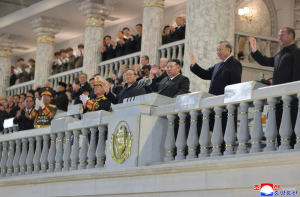On the 80th anniversary of the Workers’ Party of Korea (WPK), for the first time in decades, senior Chinese and Russian leaders watched a North Korean display featuring nuclear-capable systems. When Chinese Premier Li Qiang and Russian Security Council Deputy Chair Dmitry Medvedev stood beside North Korea’s Kim Jong Un at Pyongyang’s October 10 military parade, the message was unmistakable. Through this carefully staged act of strategic symbolism, Pyongyang projected that it is no longer isolated, while Beijing and Moscow signaled that they no longer fear being seen alongside the region’s most sanctioned regime.
The parade came amid renewed China-U.S. trade friction, as Beijing tightened exports of rare earths and Washington threatened to raise tariffs by an additional 100 percent on all Chinese exports. Meanwhile, Russia – constrained by the Ukraine war and Western sanctions – has turned toward both Beijing and Pyongyang for both diplomatic support and war materiel. Against this backdrop, North Korea’s military parade offered a theater of mutual utility: for China, a low-cost show of defiance without escalation; for Russia, proof that its diplomatic network still exists; for Kim, a rare moment of hosting major-power attention.
China and Russia approached the stage differently. Chinese state media highlighted the “traditional friendship” with North Korea and stressed “peaceful development,” avoiding any mention of missiles or common enemies. This carefully calibrated language allowed Beijing to demonstrate political support for Pyongyang while retaining diplomatic deniability over the question of Kim’s nuclear and missile programs.
Russian coverage, by contrast, centered on Medvedev’s remarks in Pyongyang that Russia and North Korea “are united in their efforts to counter Western threats and to forge a truly just world order,” as reported by TASS. Russian media framed the event as a joint act of resistance, turning the parade into an image of anti-Western cohesion. China practiced careful optics; Russia embraced theater. Pyongyang used both.
For decades, Beijing and Moscow had confined their participation in North Korean pageantry to symbolic courtesy, careful not to give the impression of too much support. When North Korea held a military parade, also featuring nuclear-capable missiles, to mark the 70th anniversary of the armistice that halted the Korean War, China sent only a Politburo member (not a Standing Committee member, much less the premier) to attend. Russian delegations at similar anniversary events usually featured parliamentary or defense envoys.
The October 2025 parade broke that pattern. With Li Qiang and Medvedev sharing the reviewing stand with Kim Jong Un as intercontinental missiles rolled past, it marked the highest-profile joint appearance of both powers at a North Korean military event in the post-Cold-War era. In visual terms, it was a small but striking escalation – from polite attendance to tacit acceptance of Pyongyang’s self-claimed status as a nuclear power.
For Kim, the event was less about deterrence than recognition. By placing foreign dignitaries at his side, Kim turned a domestic spectacle into international certification. The presence of two major powers granted Kim a visual form of external legitimacy that negotiations have never delivered.
What made the October tableau consequential, however, was not diplomatic symbolism but the growing trend of practical impact. Over the past two years, satellite imagery has shown a sustained build-out of the Tumangang-Khasan rail crossing and surges in railcar traffic on the North Korea-Russia border, usually timed with leaders’ summits. North Korea is estimated to have sent around $10 billion worth of arms – shells, self-propelled guns, ballistics missiles, surface-to-air missiles, and multiple rocket launchers – to Russia. Instead of being paid in cash for the goods, Pyongyang is receiving small amounts of food aid, plus invaluable diplomatic support – and, experts believe, technical assistance with its military modernization wish list.
In March 2024, Russia vetoed the renewal of the U.N. expert panel that had monitored the implementation of sanctions on North Korea, and China declined to support tighter enforcement. These moves are evidence of the weakening consensus within the U.N. Security Council over North Korea policy. By 2025, South Korean intelligence was openly assessing whether Russian technology had contributed to North Korea’s new Hwasong-20 ICBM, which was unveiled at the parade.
In that light, Medvedev’s applause as North Korean missiles passed by was a visual acknowledgment of years of material realignment in bilateral relations: rails upgraded, cargo moving, oversight blunted, capabilities iterating.
China’s support for North Korea is less overt, but with Russia paving the way Beijing increasingly is testing the waters for a fuller embrace of Pyongyang. On September 3, 2025, Kim was in Beijing to join Xi Jinping for China’s own military parade – the first time the North Korean leader has been granted entrance to a diplomatic event featuring dozens of heads of state and government. The symbolism was undeniable; in China’s mind, North Korea is not a “pariah” but a normal state.
The Pyongyang military parade continued the trend of diplomacy as performance. For Beijing and Moscow, attendance cost little but carried symbolic value in their rivalries with Washington. For Kim, the gain was massive: the parade was less about projecting power than about proving belonging in a reordered Asia. In an era when sanctions and summit diplomacy have stalled, visibility itself has become a currency.
Yet this triangle remains one of convenience, not conviction. Beijing avoids sanction spillover; Moscow welcomes any symbol of solidarity; Pyongyang offers stagecraft in exchange for recognition. The alignment works precisely because it is vague, and can be dialed up or down as needed.





























